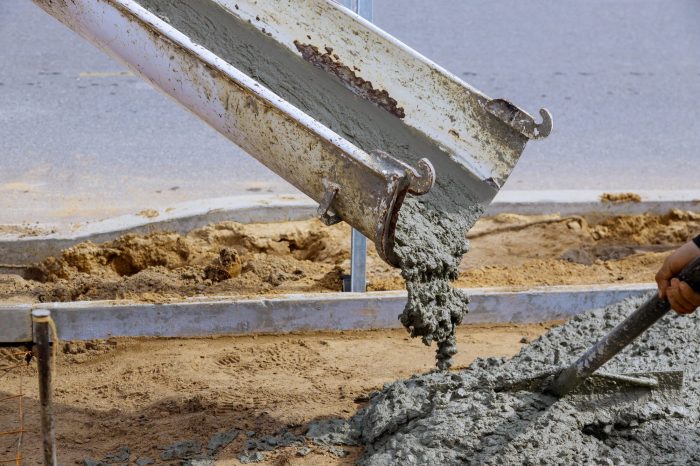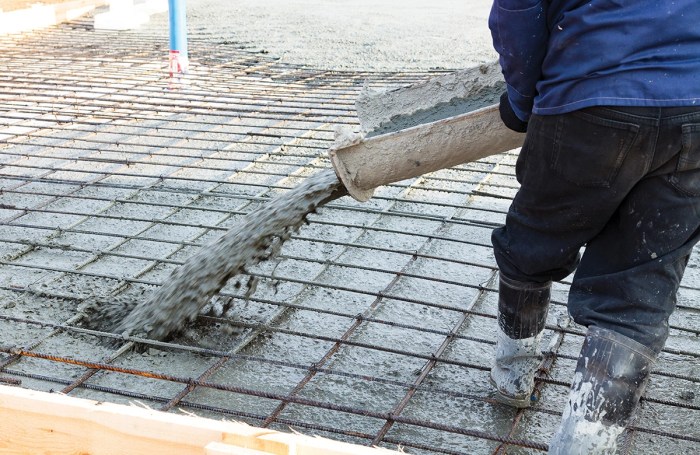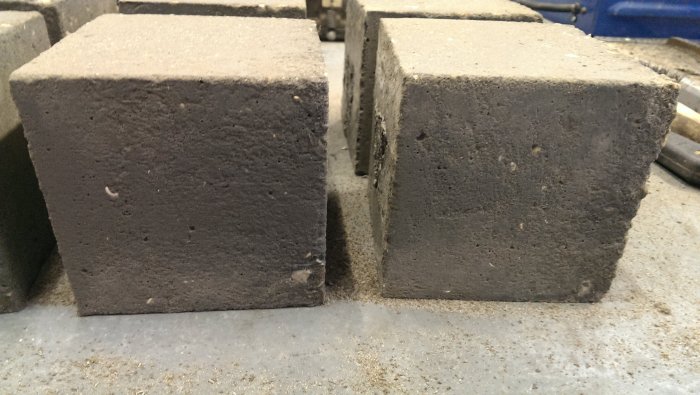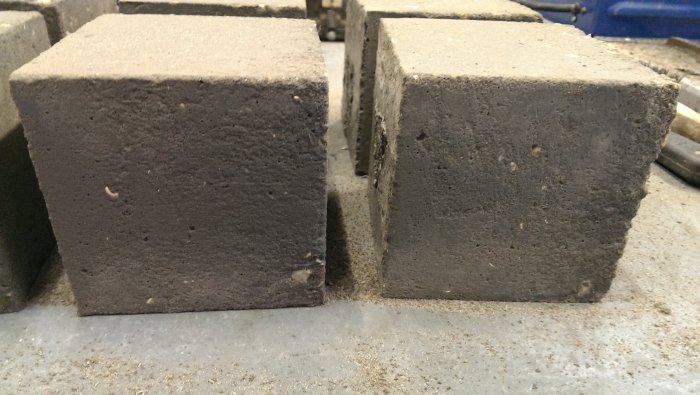Concretene uses graphene reduce concrete carbon footprint – Concretene uses graphene to reduce concrete’s carbon footprint, a groundbreaking approach that could revolutionize the construction industry. Concrete is the most widely used material on Earth, but its production is a major contributor to greenhouse gas emissions. The process of creating cement, the key ingredient in concrete, releases significant amounts of carbon dioxide into the atmosphere.
This has spurred a global search for sustainable alternatives, and graphene, a wonder material with incredible strength and flexibility, is emerging as a promising solution.
Graphene’s unique properties, including its exceptional strength and conductivity, make it an ideal additive for concrete. When incorporated into concrete mixtures, graphene can enhance the material’s durability, reduce cracking, and improve its thermal performance. These improvements can lead to longer-lasting structures, requiring less frequent repairs and replacements, thereby reducing the overall environmental impact of concrete construction.
Introduction to Concrete and its Environmental Impact

Concrete is a ubiquitous material that plays a vital role in our modern world. From towering skyscrapers to sprawling highways, concrete is the backbone of our infrastructure. However, the production and use of concrete come at a significant environmental cost.
The demand for concrete is rapidly increasing, driven by global population growth and urbanization. As cities expand and infrastructure projects are undertaken, the demand for concrete continues to rise.
The Carbon Footprint of Concrete Production
The production of concrete is a major contributor to greenhouse gas emissions, primarily due to the energy-intensive process of cement manufacturing. Cement, the key ingredient in concrete, is produced by heating limestone and other materials to extremely high temperatures in a process known as calcination.
This process releases significant amounts of carbon dioxide (CO2) into the atmosphere.
Key Contributors to the Carbon Footprint of Concrete
- Cement Manufacturing: Cement production accounts for the largest share of concrete’s carbon footprint. The calcination process, where limestone is heated to produce clinker, is responsible for the majority of CO2 emissions.
- Energy Consumption: The production of concrete requires substantial energy for various stages, including mining, transportation, and manufacturing. The source of this energy can significantly impact the carbon footprint, with fossil fuels contributing to higher emissions.
- Transportation: The transportation of raw materials and finished concrete products also contributes to emissions. The distance travelled and the mode of transport used impact the carbon footprint.
Statistics on Concrete’s Contribution to Global Greenhouse Gas Emissions
The global production of concrete accounts for a significant portion of greenhouse gas emissions. According to the International Energy Agency (IEA), concrete production is estimated to be responsible for around 8% of global CO2 emissions. This highlights the urgent need to reduce the environmental impact of concrete production.
Graphene
Graphene is a revolutionary material that has the potential to transform various industries, including construction. It is a single layer of carbon atoms arranged in a hexagonal lattice, making it incredibly strong, lightweight, and flexible. This unique combination of properties makes graphene an ideal candidate for enhancing concrete properties and reducing its carbon footprint.
Graphene’s Exceptional Properties
Graphene’s remarkable properties stem from its unique atomic structure. Its exceptional strength, conductivity, and flexibility make it an ideal additive for enhancing concrete performance.
- Strength: Graphene is the strongest material known to man, with a tensile strength that is 200 times stronger than steel. This exceptional strength can significantly enhance the compressive strength and durability of concrete.
- Conductivity: Graphene is an excellent conductor of electricity and heat. Incorporating graphene into concrete can improve its thermal conductivity, making it more resistant to temperature fluctuations and potentially reducing energy consumption for heating and cooling buildings.
- Flexibility: Graphene’s flexibility allows it to bridge cracks in concrete, preventing further propagation and enhancing the material’s overall durability.
Potential Benefits of Graphene-Enhanced Concrete
The exceptional properties of graphene can significantly enhance concrete performance, leading to a range of benefits:
- Increased Durability: Graphene’s strength and flexibility can improve the durability of concrete, making it more resistant to cracking, abrasion, and weathering.
- Reduced Cracking: Graphene’s ability to bridge cracks can prevent further propagation, extending the lifespan of concrete structures and reducing maintenance costs.
- Improved Thermal Performance: Graphene’s high thermal conductivity can enhance the thermal performance of concrete, making it more resistant to temperature fluctuations and potentially reducing energy consumption for heating and cooling buildings.
- Reduced Carbon Footprint: Graphene can reduce the amount of cement required for concrete production, thereby reducing the carbon footprint of the construction industry.
Real-World Applications
The potential of graphene-enhanced concrete is already being explored in real-world applications. Researchers and companies are developing and testing various applications, including:
- Self-healing Concrete: Graphene can be incorporated into concrete to create self-healing properties. When cracks occur, graphene can bridge the gaps and prevent further propagation.
- Conductive Concrete: Graphene’s high conductivity can be utilized to create conductive concrete, which can be used for applications such as heating systems, de-icing systems, and even sensors.
- Lightweight Concrete: Graphene can be used to create lightweight concrete, which can reduce the weight of structures and improve their seismic resistance.
How Graphene Can Contribute to a More Sustainable Concrete Industry
The construction industry is a major contributor to global greenhouse gas emissions, with concrete production alone accounting for a significant portion of these emissions. This is due to the high energy requirements of cement production, which is the primary ingredient in concrete.
However, recent advancements in nanotechnology have brought about a potential solution to this problem: graphene. This remarkable material, known for its exceptional strength and versatility, can be incorporated into concrete to enhance its properties and significantly reduce its environmental impact.
Graphene’s Role in Reducing Concrete’s Carbon Footprint
Graphene can help reduce the carbon footprint of concrete production in several ways. Its addition to concrete can lead to a decrease in the amount of cement required, thereby lowering the energy needed for its production. Additionally, graphene’s unique properties can improve the efficiency of cement production, potentially leading to lower emissions.
- Reduced Cement Consumption:Graphene’s exceptional strength and durability allow for the use of less cement in concrete mixtures. Studies have shown that incorporating even small amounts of graphene can significantly increase the strength and durability of concrete, enabling the use of lower cement ratios.
For instance, a study published in the journal “Construction and Building Materials” found that adding 0.05% graphene by weight to concrete resulted in a 20% increase in compressive strength. This reduction in cement content translates to a lower carbon footprint, as less energy is required for its production.
- Enhanced Cement Hydration:Graphene acts as a catalyst, accelerating the hydration process of cement, which is the chemical reaction that transforms cement powder into a hardened concrete matrix. This accelerated hydration leads to faster setting times and reduced energy consumption during the curing process.
Additionally, graphene’s presence can enhance the microstructure of concrete, leading to improved mechanical properties and reduced permeability, further reducing the need for high cement content.
- Reduced Waste Generation:Graphene’s ability to enhance concrete’s durability can contribute to a reduction in waste generation from demolition and reconstruction. By creating more durable and long-lasting concrete structures, graphene can extend their lifespan, reducing the need for frequent repairs and replacements. This translates to a significant reduction in construction waste, which is a major contributor to environmental pollution.
Graphene’s Contribution to Durable and Long-Lasting Concrete Structures
Graphene’s unique properties, such as its high tensile strength, exceptional electrical conductivity, and excellent thermal properties, make it an ideal additive for enhancing the performance and durability of concrete.
- Increased Strength and Durability:Graphene’s remarkable strength and stiffness, which are significantly higher than steel, can significantly improve the strength and durability of concrete. By reinforcing the concrete matrix at the nanoscale, graphene enhances its resistance to cracking, wear, and tear, resulting in longer-lasting structures that require less maintenance.
This reduced need for repairs and replacements further contributes to a more sustainable construction industry.
- Enhanced Resistance to Environmental Degradation:Graphene’s hydrophobic properties, meaning it repels water, can significantly improve the resistance of concrete to environmental degradation. This is particularly important in harsh environments, such as coastal areas or regions with frequent freeze-thaw cycles, where concrete structures are prone to deterioration due to moisture ingress.
Graphene’s ability to enhance the water resistance of concrete can extend its lifespan and reduce the need for costly repairs.
- Improved Thermal Performance:Graphene’s excellent thermal conductivity can enhance the thermal performance of concrete, making it more resistant to temperature fluctuations. This is particularly beneficial in regions with extreme temperatures, where concrete structures can experience thermal stress and cracking. Graphene’s ability to dissipate heat more effectively can help mitigate these issues and contribute to the longevity of concrete structures.
Understand how the union of blockchain development tech career can improve efficiency and productivity.
Applications of Graphene-Reinforced Concrete

The integration of graphene into concrete opens a new chapter in construction, offering a range of applications with enhanced properties and improved performance. Research and development projects are exploring the potential of graphene-reinforced concrete in various infrastructure projects, showcasing its ability to enhance durability, strength, and sustainability.
Applications in Buildings
Graphene-reinforced concrete holds significant promise for enhancing the structural integrity and sustainability of buildings. Research suggests that graphene can improve the compressive strength, tensile strength, and flexural strength of concrete, making it more resistant to cracking and damage. Additionally, graphene can enhance the fire resistance and thermal insulation properties of concrete, contributing to safer and more energy-efficient buildings.
Applications in Roads and Bridges, Concretene uses graphene reduce concrete carbon footprint
Graphene-reinforced concrete can revolutionize the construction of roads and bridges, offering improved durability, resilience, and longevity. Graphene can enhance the crack resistance and fatigue resistance of concrete, reducing the need for frequent repairs and maintenance. This is particularly important for infrastructure exposed to harsh weather conditions and heavy traffic loads.
Applications in Infrastructure Resilience
Graphene-reinforced concrete can play a crucial role in enhancing the resilience of infrastructure to extreme weather events. Research suggests that graphene can improve the resistance of concrete to freeze-thaw cycles, reducing the risk of damage caused by temperature fluctuations. This is especially beneficial for infrastructure located in regions prone to extreme weather conditions, such as those experiencing frequent freezing and thawing cycles.
Challenges and Future Directions: Concretene Uses Graphene Reduce Concrete Carbon Footprint

While graphene-reinforced concrete holds immense promise for a more sustainable future, its widespread adoption faces several challenges that require addressing. These challenges encompass the technical aspects of production and implementation, as well as the need for further research and development.
Scaling Up Production and Use
The successful implementation of graphene-reinforced concrete requires overcoming several obstacles related to scaling up its production and use.
- Cost-Effective Production:The high cost of graphene production remains a significant barrier. Current production methods are energy-intensive and often result in low yields, making graphene significantly more expensive than traditional concrete additives.
- Uniform Dispersion:Achieving uniform dispersion of graphene within the concrete matrix is crucial for maximizing its reinforcing effects. Graphene’s tendency to agglomerate can hinder its ability to enhance concrete properties.
- Large-Scale Applications:Scaling up graphene production to meet the demands of large-scale construction projects presents significant challenges. Existing production methods may not be readily adaptable to meet the increased demand.
Further Research and Development
Further research and development are essential to optimize the use of graphene in concrete and address its limitations.
- Improved Graphene Production:Developing cost-effective and environmentally friendly methods for producing graphene in large quantities is paramount. Research efforts are underway to explore alternative production methods, such as electrochemical exfoliation and plasma-assisted synthesis, which could reduce production costs and environmental impact.
- Enhanced Dispersion Techniques:Developing effective methods for dispersing graphene within the concrete matrix is critical. Research focuses on developing novel dispersants and techniques that can prevent graphene agglomeration and ensure uniform distribution throughout the concrete mixture.
- Optimizing Graphene-Concrete Interactions:Understanding the complex interactions between graphene and concrete components is essential for optimizing its reinforcing effects. Research aims to investigate the impact of graphene on concrete’s mechanical properties, durability, and long-term performance.
Collaboration and Partnerships
To accelerate the adoption of graphene-based concrete technologies, collaboration between industry, academia, and government is crucial.
- Industry-Academia Partnerships:Collaborative research initiatives between industry and academia can facilitate the development and testing of graphene-reinforced concrete technologies. Industry can provide real-world applications and testing environments, while academia can contribute expertise in materials science, engineering, and research methodologies.
- Government Support:Government support through funding, policy initiatives, and infrastructure development can foster innovation and accelerate the adoption of graphene-based concrete technologies. Policies that incentivize the use of sustainable construction materials and promote research and development in graphene-based concrete can significantly impact the industry’s transition towards a more sustainable future.
- Knowledge Sharing:Open communication and knowledge sharing between stakeholders are essential for accelerating the adoption of graphene-reinforced concrete. Establishing platforms for information exchange and best practice sharing can facilitate the dissemination of research findings, technical advancements, and industry best practices.
Illustrative Examples of Graphene-Reinforced Concrete Applications
Now, let’s delve into some practical examples of how graphene-reinforced concrete is revolutionizing various construction sectors. These applications demonstrate the versatility and potential of this innovative material in creating a more sustainable future.
Examples of Graphene-Reinforced Concrete Applications
The following table showcases specific examples of graphene-reinforced concrete applications, outlining their unique characteristics, advantages, and potential environmental impact.
| Application | Description | Benefits | Potential Impact |
|---|---|---|---|
| High-Performance Bridges | Graphene-reinforced concrete can be used to construct bridges with increased strength, durability, and resistance to cracking. This leads to longer lifespans and reduced maintenance costs. |
|
|
| Lightweight Concrete Structures | Graphene’s remarkable properties allow for the creation of lighter concrete structures, leading to significant cost savings in transportation and construction. |
|
|
| Self-Healing Concrete | Graphene-reinforced concrete exhibits self-healing properties, where microscopic cracks can be repaired autonomously, extending the lifespan of structures and reducing maintenance needs. |
|
|
| 3D-Printed Concrete Structures | Graphene-reinforced concrete is highly suitable for 3D printing, enabling the creation of complex and intricate structures with enhanced strength and durability. |
|
|


